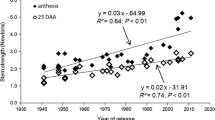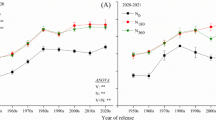Abstract
The plant characteristics required to make wheat lodging-proof for the least investment of biomass are calculated using a validated model of the lodging process and information about the dry matter costs of altering lodging-associated characters. The plant characteristics required to give a crop yielding 8 t ha−1 with 500 shoots m−2 and 200 plants m−2, a lodging return period of 25 years include a height of 0.7 m, a root plate spread of 57 mm, and for the bottom internode a wall width of 0.65 mm with a diameter/material strength combination ranging from a diameter of 5.86 mm with a material strength of 20 MPa to a diameter of 4.00 mm with a material strength of 50 MPa. It is estimated that this ideotype would require 7.9 t ha−1 of stem biomass and would have a harvest index of 0.42. Observations of a wide range of varieties grown using crop management to maximise lodging resistance without reducing yield potential showed that the root plate of the best variety was 7 mm less than the ideotype target, the stem character targets were achieved but not all in one variety, and the height target was achievable with the use of plant growth regulators. Plant breeders must therefore focus on selecting for a wider root plate and combining the appropriate stem strength characteristics.





Similar content being viewed by others
References
Allan RE (1986) Agronomic comparisons among wheat lines nearly isogenic for three reduced height genes. Crop Sci 26:707–710
Anon. (2000) Fertiliser recommendations for agricultural and horticultural crops. 7th edn. MAFF (now DEFRA) Reference Book 209. HMSO, London
Austin RB, Ford MA, Morgan CL (1989) Genetic improvement in the yield of winter: a further evaluation. J Agric Sci Camb 112:295–301
Austin RB (1999) Yield of wheat in the United Kingdom: recent advances and prospects. Crop Sci 39:1604–1610
Austin RB, Bingham J, Blackwell RD, Evans L, Ford MA, Morgan CL, Taylor M (1980) Genetic improvements in winter wheat yields since 1900 and associated physiological changes. J Agric Sci Camb 94:675–689
Baker CJ, Berry PM, Spink JH, Sylvester-Bradley R, Griffin JM, Scott RK, Clare RW (1998) A method for the assessment of the risk of wheat lodging. J Theor Biol 194:587–603
Barraclough PB, Leigh RA (1984) The growth and activity of winter wheat roots in the field: the effect of sowing date and soil type on root growth of high yielding crops. J Agric Sci Camb 103:59–74
Baylan HS, Singh O (1994) Pleiotropic effects of GA-insensitive Rht genes on grain yield and its component characters in wheat. Cereal Res Commun 22:195–200
Berry PM (2004) Designing lodging-proof wheat. Aspects Appl Biol 72:177–184
Berry PM, Griffin JM, Sylvester-Bradley R, Scott RK, Spink JH, Baker CJ, Clare RW (2000) Controlling plant form through husbandry to minimise lodging in wheat. Field Crops Res 67:59–81
Berry PM, Spink JH, Sylvester-Bradley R, Pickett A, Sterling M, Baker C, Cameron N (2002) Lodging control through variety choice and management. In: Proceedings of the eighth home-grown cereals authority R&D conference on cereals and oilseeds. HGCA, London, pp 7.1–7.12
Berry PM, Sterling M, Baker CJ, Spink JH, Sparkes DL (2003a) A calibrated model of wheat lodging compared with field measurements. Agric For Meteorol 119:167–180
Berry PM, Spink JH, Gay AP, Craigon J (2003b) A comparison of root and stem lodging risks among winter wheat cultivars. J Agric Sci Camb 141:191–202
Berry PM, Sterling M, Spink JH, Baker CJ, Sylvester-Bradley R, Mooney S, Tams A, Ennos AR (2004) Understanding and reducing lodging in cereals. Adv Agron 84:215–269
Berry PM, Sterling M, Mooney SJ (2006) Development of a model of lodging for barley. J Agron Crop Sci 192:151–158
Cosser ND, Gooding MJ, Thompson AJ, Froud-Williams RJ (1997) Competitive ability and tolerance of organically grown cultivars to natural weed infestations. Ann Appl Biol 130:523–525
Crook MJ, Ennos AR (1995) The effect of nitrogen and growth regulators on stem and root characteristics associated with lodging in two cultivars of winter wheat. J Exp Bot 46:931–938
Crook MJ, Ennos AR, Sellers EK (1994) Structural development of the shoot and root systems of two winter wheat cultivars (Triticum aestivum L.). J Exp Bot 45:867–875
Easson DL, White EM, Pickles SJ (1993) The effects of weather, seed rate and cultivar on lodging and yield in winter wheat. J Agric Sci Camb 121:145–156
Ellis MH, Spielmeyer W, Gale KR, Rebetzke GJ, Richards RA (2002) “Perfect” markers for the Rht-B1b and Rht-D1b dwarfing genes in wheat. Theor Appl Genet 105:1038–1042
Fischer RA (1985) Number of kernels in wheat crops and the influence of solar radiation and temperature. J Agric Sci Camb 105:447–461
Flintham JE, Borner A, Worland AJ, Gale MD (1997) Optimizing wheat grain yield: effects of Rht (gibberellin-insensitive) dwarfing genes. J Agric Sci Camb 128:11–25
Ford KE, Gregory PJ, Gooding MJ, Pepler S (2002) Root length density variation in modern winter wheat cultivars. In: Villalobos FJ, Testi L (eds.) Proceedings of VII congress of the European Society of Agronomy. Consejeria de Agricultura y Pesca, Cordoba, pp361–362
Garthwaite DG, Thomas MR, Anderson H, Stoddart H (2005). Pesticide Usage Survey Report 202. Arable crops in Great Britain 2004. Department for the Environment Food and Rural Affairs, London
Kertesz Z, Flintham JE, Gale MD (1991) Effects of Rht dwarfing genes on wheat grain yield and its components under Eastern European conditions. Cereal Res Commun 19:297–304
Lane PW, Payne RW (1996) Genstat for Windows: an introductory course, 2nd edn. Numerical Algorithms Group Limited, Oxford
Miralles DJ, Slafer GA (1995) Individual grain weight responses to genetic reductions in culm length in wheat as affected by source–sink manipulations. Field Crops Res 43:55–66
Mulder EG (1954) Effect of mineral nutrition on lodging of cereals. Plant Soil 5:246–306
Parker SR, Lovell DJ, Foulkes MJ, Worland AJ, Paveley ND (2002) Improving and exploiting self defence against wheat diseases. In: Proceedings of the Brighton crop protection conference. Brighton, UK, pp919–924
Richards RA (1992a) The effect of dwarfing genes in spring wheat in dry environments. I. Agronomic characteristics. Aust J Agric Res 43:517–527
Richards RA (1992b) The effect of dwarfing genes in spring wheat in dry environments. II. Growth, water use and water use efficiency. Aust J Agric Res 43:529–539
Shearman V, Sylvester-Bradley R, Scott RK, Foulkes J (2005) Changes in physiological processes associated with recent genetic increases in grain yield of winter wheat in the UK. Crop Sci 45:175–185
Spink JH, Berry PM, Wade AP, White EL (2004) Minimising chlormequat residues in harvested grain. Home-Grown Cereals Authority Research Project No. 332. HGCA, London, 44 pp
Spink JH, Berry PM, Theobald C, Sparkes D, Wade AP, Roberts A (2005) Effects of location and management on optimum seed rate for winter wheat. Home-Grown Cereals Authority Research Project No. 353. HGCA, London, 161 pp
Stapper M, Fischer RA (1990) Genotype, sowing date and plant spacing influence on high-yielding irrigated wheat in Southern New South Wales. II. Growth, yield and nitrogen use. Aust J Agric Res 41:1021–1041
Sylvester-Bradley R, Scott RK, Clare RW, Duffield SJ (1998) Assessments of wheat growth to support its production and improvement. Home-Grown Cereals Authority Research Project No. 151. HGCA, London, 125 pp
Acknowledgments
Funding from Advanta Seeds UK Ltd., Defra, and HGCA are gratefully acknowledged. This work was sponsored by Defra through the Sustainable Arable LINK Programme.
Author information
Authors and Affiliations
Corresponding author
Rights and permissions
About this article
Cite this article
Berry, P.M., Sylvester-Bradley, R. & Berry, S. Ideotype design for lodging-resistant wheat. Euphytica 154, 165–179 (2007). https://doi.org/10.1007/s10681-006-9284-3
Received:
Accepted:
Published:
Issue Date:
DOI: https://doi.org/10.1007/s10681-006-9284-3




